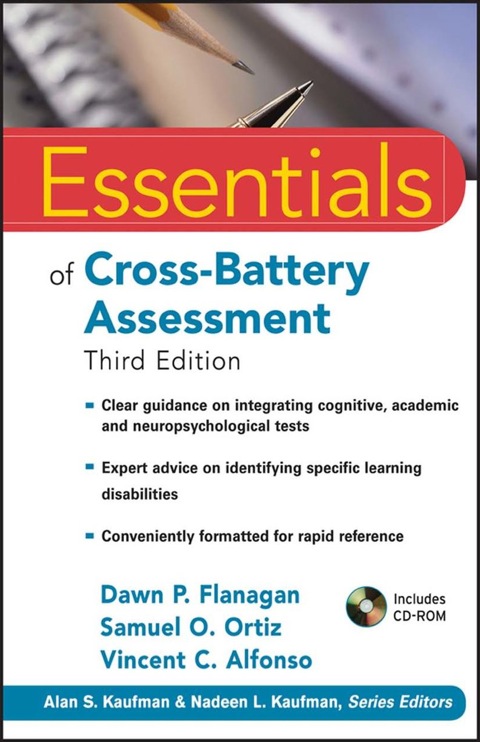Description
Efnisyfirlit
- Contents
- Series Preface
- Acknowledgments
- One: Overview
- DEFINITION
- FOUNDATION OF THE XBA APPROACH
- CHC THEORY
- Original Gf-Gc Theory and the Cattell-Horn Expanded Gf-Gc Theory: First Precursors to CHC Theory
- Carroll’s Three-Stratum Theory: Second Precursor to CHC Theory
- Comparison of the Cattell-Horn and Carroll Theories
- Decade of CHC Theory (2001–2011)
- Refinements and Extensions to CHC Theory
- CHC Broad (Stratum II) Classifications of Cognitive, Academic, and Neuropsychological Ability Tests
- CHC Narrow (Stratum I) Classifications of Cognitive, Academic, and Neuropsychological Ability Tests
- RATIONALE FOR THE XBA APPROACH
- Practice (2000–2010)
- TEST DEVELOPMENT
- GUIDING PRINCIPLES OF THE XBA APPROACH
- CONCLUSIONS
- REFERENCES
- Two: How to Organize a Cross-Battery Assessment Using Cognitive, Achievement, and Neuropsychological
- OVERVIEW
- UTILIZATION OF SPECIFIC REFERRAL INFORMATION
- Scenario 1: Cognitive-Achievement Relations
- Scenario 2: Practical and Legal Considerations
- Scenario 3: Consideration of Examinee Characteristics
- INTEGRATING GUIDING PRINCIPLES WITH DECISION MAKING
- CROSS-BATTERY ASSESSMENT DATA MANAGEMENT AND INTERPRETIVE ASSISTANT (XBA DMIA v2.0)
- Implementing the XBA Approach Step by Step
- Step 1: Select an Ability Battery
- Step 2: Identify the CHC Broad Abilities That Are and Are Not Measured by the Selected Battery
- Step 3: Identify the CHC Narrow Abilities That Are and Are Not Measured by the Selected Battery
- Step 4: Administer and Score Selected Battery and Supplemental Tests
- Step 5: Enter Scores into the Cross-Battery Assessment Data Management and Interpretive Assistant (X
- SUMMARY
- REFERENCES
- Three: How to Interpret Test Data
- HYPOTHESIS-DRIVEN ASSESSMENT AND INTERPRETATION
- INTEGRATING HYPOTHESIS TESTING AND INTERPRETATION
- Stage A: CHC Theory, Neuropsychological Theory, and Research Knowledge Bases
- Stage B: Specification of a Priori Hypotheses
- Stage C: Construction of a Cross-Battery Assessment
- Stage D: Administration and Scoring of Ability Battery and Supplemental Tests
- Stages E1 and E2: Interpretation of Results and Evaluation of Hypotheses
- Stage F: Specification of a Posteriori Hypotheses
- Stage G: Incorporate XBA Results in a Psychological Report
- SUMMARY
- REFERENCES
- Four: Cross-Battery Assessment for SLD Identification: The Dual Discrepancy/Consistency Pattern of S
- BRIEF PERSPECTIVE ON THE DEFINITION OF SLD
- NEED FOR AN OPERATIONAL DEFINITION OF SLD
- DUAL DISCREPANCY/CONSISTENCY (DD/C) OPERATIONAL DEFINITION OF SLD
- Levels of Evaluation in the DD/C Definition
- SUMMARY OF THE DD/C OPERATIONAL DEFINITION OF SLD
- SUMMARY
- REFERENCES
- Five: Cross-Battery Assessment of Individuals From Culturally and Linguistically Diverse Backgrounds
- INTRODUCTION
- EVALUATION OF CURRENT APPROACHES FOR ASSESSING DIVERSE INDIVIDUALS
- Modified and Altered Testing
- Nonverbal Testing
- Native-Language Testing
- English-Language Testing
- CULTURE-LANGUAGE TEST CLASSIFICATIONS AND INTERPRETIVE MATRIX
- Culture-Language Test Classifications
- CHC Culture-Language Interpretive Matrix
- Use of the XBA C-LIM v2.0
- Evaluating the Impact of Culture and Language on Test Score Validity With the XBA C-LIM v2.0
- Additional Considerations in Using the XBA C-LIM v2.0
- CONCLUSION
- REFERENCES
- Six: Strengths and Weaknesses of the Cross-Battery Assessment Approach
- STRENGTHS
- Contemporary Theory
- Communication
- Psychometrically Defensible Cross-Battery Composites
- Enhancement in Evaluation of Specific Learning Disabilities and Individuals From Culturally and Ling
- Flexibility
- Automation
- WEAKNESSES
- Norm Samples
- Complicated
- Time Consuming
- REFERENCES
- Seven: Cross-Battery Assessment Case Report
- COMPREHENSIVE EVALUATION
- REASON FOR REFERRAL
- BACKGROUND INFORMATION
- BEHAVIOR OBSERVATIONS
- EVALUATION RESULTS
- Intellectual/Cognitive
- Achievement
- Self-Report
- Classroom Observation
- Student Interview
- CONCLUSIONS
- RECOMMENDATIONS
- Written Expression
- Appendix A: CHC Narrow Ability Definitions and Task Examples
- Appendix B: CHC Broad and Narrow Ability Classification Tables for Tests Published Between 2001 and
- Appendix C: Descriptions of Cognitive, Achievement, and Neuropsychological Subtests by CHC Domain
- Appendix D: Critical Values for Statistical Significance and Base Rate for Composites on Comprehensi
- Appendix E: Variation in Task Demands and Task Characteristics of Subtests on Cognitive and Neuropsy
- Appendix F: Variation in Task Demands and Task Characteristics of Subtests on Achievement Batteries
- Appendix G: Neuropsychological Domain Classifications
- Appendix H: Understanding and Using the XBA PSW-A v1.0 Software Program Tab by Tab
- Appendix I: Cognitive and Neuropsychological Battery-Specific Culture-Language Matrices
- Appendix J: Cross-Battery Assessment Case Reports
- Appendix K: Eugene, Oregon, School District Integrated Model for Specific Learning Disability Identi
- Appendix L: Summary of the Expert Consensus Study for Determining CHC Broad and Narrow Ability Class
- Appendix M: Criteria Used in XBA DMIA v2.0 for Follow-Up on a Two-Subtest Composite
- Author Index
- Subject Index
- About the Authors
- About the CD






Reviews
There are no reviews yet.